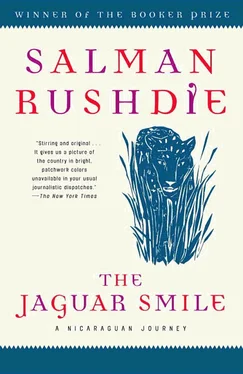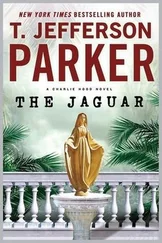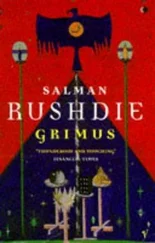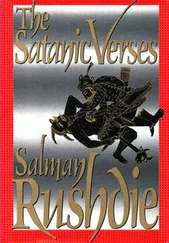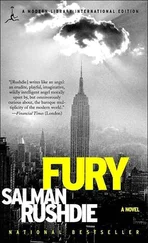‘Obviously we don’t make them move by coercion,’ Arce spoke, his words sidling past the obstacle of his cigar. ‘It requires persuasion, political work.’
Wheelock said, ‘It’s because we have given them land. Now they have their own land, they have a base. And then different harvests happen at different times, so it is a way for them to use their slack periods profitably.’
‘Still, it’s surprising they’re willing to be so mobile,’ I said.
Wheelock smiled happily. ‘It is because they have great trust in the revolution, now.’
O the beauty of the mountains at Estelí. They sprang from the earth in improbable, contorted forms, in shapes plenty of fantasy , as the old tobacco map had put it. Sixty or seventy thousand of us had crowded into the plaza, cradled by the mountains’ encircling arms. Banners waved: power to the people . And, on the Tannoy, as we waited for the Acta to get under way, there was 1950s rock music. Estelí danced to ‘Rock Around the Clock’ .
Backstage, in a hospitality room under the main stand, the Sandinista leadership was receiving messages from the front. Short-wave radio brought the news that two large Contra groupings had been identified, and had crossed the frontier into Nicaragua. Ortega, Arce, Wheelock and the others went out to greet the crowd.
Daniel Ortega would never be a natural orator, but according to the old hands I asked, he had become much, much better at public speaking than he used to be. ‘You should have heard him last year,’ one party worker whispered to me. ‘Phoo!’
I thought he spoke simply and well, if a little stilted when he waxed rhetorical. He said, not for the first time, that Reagan was ‘worse than Hitler’, and that was plain silly. But he was much more effective when he listed the numbers of teachers, doctors, volunteer workers and campesinos who had died in the last year, and spread his arms wide after each statistic to demand from the people: ‘Quién es culpable?’ (Who is to blame?) And they roared back their answer: ‘Reagan.’
One day, he said, when Nicaragua was at peace, history would remember there was a nation that would not lie down and be crushed.
‘Patria libre!’
‘O MORIR.’
That evening we were back in Managua, and the good news was that the the Contra had not managed to do a single thing all day. No roads had been mined, no campesinos attacked, no bridges blown. Nada . At the old Somocista country club, Managua was having a party. Salsa and bossa nova music filled the night sky. I looked at the dancers and thought that it was not the moment for an escritor hindú to disgrace himself by attempting to compete with such performers.
Somebody took my elbow. I turned to find a small, elderly gentleman with a cane nodding meaningfully at me. He was, of course, a poet. ‘I greatly admire,’ he said to me, ‘your Indian poet, Tagoré.’
I was taken aback. What was old Rabindranath doing here, with this accent on his final e? ‘Is he translated here?’ I asked.
‘Victoria Ocampo, the great Argentine editor and intellectual, fell in love with the work, and with the man,’ came the reply. ‘I do not know, however, if they had an affaire . I suspect not. But Victoria Ocampo was determined that Latin America should discover this great genius, and she published many excellent translations.’
‘Then Tagore is better read in Latin America than in India,’ I said. ‘There, many of the translations are very bad indeed.’
‘Tagoré,’ he corrected me. ‘I admire him for his spiritual qualities, and also his realism.’
‘Many people think of Latin America as the home of anti-realism,’ I said. He looked disgusted. ‘Fantasy?’ he cried. ‘No, sir. You must not write fantasy. It is the worst thing. Take a tip from your great Tagoré. Realism, realism, that is the only thing.’
I escaped from the admonitory shade of Rabindranath and sat down with Rosario Murillo and Hugo Torres, the Frente’s political education chief (and, what else, a poet). Also at the table were Susan Meiselas, the American photographer whose work in Salvador and Nicaragua I had long admired, and an American film producer, Burt Schneider. I arrived as Rosario was wondering how the people of the USA could tolerate what their government was doing to this tiny country.
‘You’ve got to understand that for Americans, Nicaragua has no reality,’ said Burt, a tall rawboned man with long arms and large gestures. ‘To them it’s just another TV show. That’s all it is.’ He went on to argue that the US would never invade Nicaragua because of the memory of Vietnam. Susan Meiselas said she found it hard to be so optimistic. So did I; in neoconservative America, the lesson of Vietnam seemed to be that the real mistake had been to quit when they did, instead of staying to finish the job.
‘The trouble is, Rosario,’ Schneider cried, ‘nobody knows if you’re communists. Hell, I don’t know myself. What do you reckon, Susan?’ He leaned conspiratorially across the table to Meiselas, ‘Does she look like a Commie to you?’ Schneider had known Rosario a long time, and she and Torres both smiled politely, but the joke fell pretty flat.
In the background, the nine comandantes de la revolución were having their picture taken. It was the only time I ever saw them all together, and my only glimpse of Tomás Borge, a tiny gnome with a large cigar.
‘Look at them,’ Burt said lovingly. ‘Looks like a school photo, doesn’t it? Isn’t it a privilege to be here with them, on this day?’
‘Yes,’ I said, ‘it is.’ Happy birthday, Nicaragua. I drank a toast in the best rum in the world, Flor de Caña Extra Seco. Mixed with Coke, it was called a Nica-libre, and after a few glasses I was ready to take on the salsa champions and knock them dead. I went outside to dance.
6

THE WORD
In the octagonal church of Santa María de los Ángeles in the Riguero barrio of Managua, Father Uriel Molina stood in full regalia in front of a packed congregation with a pop group at his back. The modern church looked like a tepee of metal girders. Its walls were covered in luridly coloured murals. Sandino, wearing his hat even though he was in church, and Carlos Fonseca, his goatee and specs looking iconically, as they always did, up and into the future, were both present on the walls, but on modest side-panels, playing a strictly supporting role, on this occasion, to Christ and his angels.
(The characteristic Fonseca pose was clearly based on the old images of Lenin thrusting his beard forward, ever forward. It struck me that, in this supposed hotbed of Marxism-Leninism, this was as close to a picture of Lenin as I’d come. I did, eventually, get to see both Vladimir Ilyich and the old bastard Marx himself: their portraits flanked a rather bemused-looking Sandino at the headquarters of the biggest trade union, the CST [Central Sandinista de Trabajadores]. Compared to, for example, Kerala, where graffiti of Lenin speaking Malayalam sprouted on every second wall, and trucks could be named STALIN JOSÉ, the Reds in Nicaragua were keeping a pretty low profile.)
I had come out to this poor barrio , whose people had been prominent in the insurrection, to hear the ‘Misa Campesina’, the peasants’ mass created by Ernesto Cardenal and Carlos Mejía Godoy, whose gift for the hummable tune might be envied by Paul McCartney. The Misa Campesina was one of the most striking manifestations of liberation theology, which, in Nicaragua, had introduced into church services such versicles-and-responses as: ‘Between the Church and the Revolution/There is no contradiction.’ I had also wanted to get a look at Father Molina, one of the most visible of the liberation-theology priests, an early influence on Luis Carrión, and the founder of the Valdivieso Centre, at which the ideas of the Popular Church were hammered out. The expelled Bishop Vega had attacked the Valdivieso Centre people as a bunch of liars. ‘The problem is that they use the Marxist method. For a Marxist … to tell a lie is valid because with it you can better implant the ideology.’ And the American journalist Shirley Christian, in her book Nicaragua: Revolution in the Family , a book that was waspishly hostile to most aspects of post-Somoza Nicaragua (and, among other things, presented a sympathetic portrait of an escaped Somocista officer of the National Guard, Leo Salazar, who called Somoza ‘a wonderful man’), described Father Molina as ‘a television talk-show host.’
Читать дальше
